Vladimir Somers
SoccerNet 2025 Challenges Results
Aug 26, 2025Abstract:The SoccerNet 2025 Challenges mark the fifth annual edition of the SoccerNet open benchmarking effort, dedicated to advancing computer vision research in football video understanding. This year's challenges span four vision-based tasks: (1) Team Ball Action Spotting, focused on detecting ball-related actions in football broadcasts and assigning actions to teams; (2) Monocular Depth Estimation, targeting the recovery of scene geometry from single-camera broadcast clips through relative depth estimation for each pixel; (3) Multi-View Foul Recognition, requiring the analysis of multiple synchronized camera views to classify fouls and their severity; and (4) Game State Reconstruction, aimed at localizing and identifying all players from a broadcast video to reconstruct the game state on a 2D top-view of the field. Across all tasks, participants were provided with large-scale annotated datasets, unified evaluation protocols, and strong baselines as starting points. This report presents the results of each challenge, highlights the top-performing solutions, and provides insights into the progress made by the community. The SoccerNet Challenges continue to serve as a driving force for reproducible, open research at the intersection of computer vision, artificial intelligence, and sports. Detailed information about the tasks, challenges, and leaderboards can be found at https://www.soccer-net.org, with baselines and development kits available at https://github.com/SoccerNet.
CAMELTrack: Context-Aware Multi-cue ExpLoitation for Online Multi-Object Tracking
May 02, 2025Abstract:Online multi-object tracking has been recently dominated by tracking-by-detection (TbD) methods, where recent advances rely on increasingly sophisticated heuristics for tracklet representation, feature fusion, and multi-stage matching. The key strength of TbD lies in its modular design, enabling the integration of specialized off-the-shelf models like motion predictors and re-identification. However, the extensive usage of human-crafted rules for temporal associations makes these methods inherently limited in their ability to capture the complex interplay between various tracking cues. In this work, we introduce CAMEL, a novel association module for Context-Aware Multi-Cue ExpLoitation, that learns resilient association strategies directly from data, breaking free from hand-crafted heuristics while maintaining TbD's valuable modularity. At its core, CAMEL employs two transformer-based modules and relies on a novel association-centric training scheme to effectively model the complex interactions between tracked targets and their various association cues. Unlike end-to-end detection-by-tracking approaches, our method remains lightweight and fast to train while being able to leverage external off-the-shelf models. Our proposed online tracking pipeline, CAMELTrack, achieves state-of-the-art performance on multiple tracking benchmarks. Our code is available at https://github.com/TrackingLaboratory/CAMELTrack.
SoccerNet 2024 Challenges Results
Sep 16, 2024
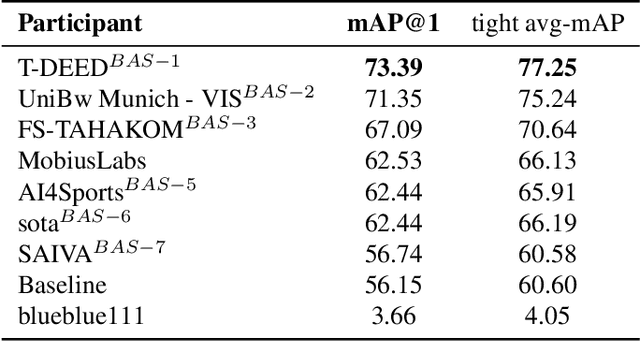
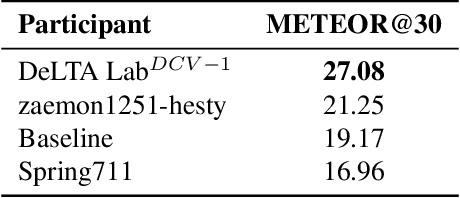
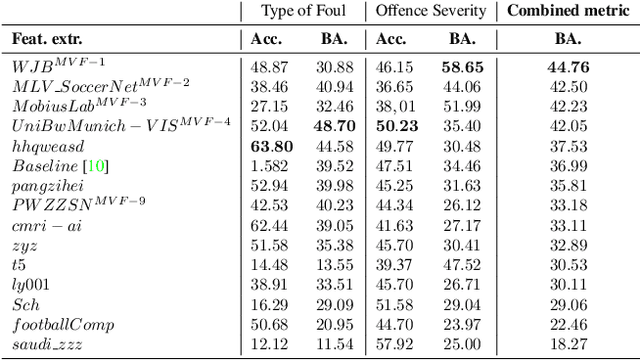
Abstract:The SoccerNet 2024 challenges represent the fourth annual video understanding challenges organized by the SoccerNet team. These challenges aim to advance research across multiple themes in football, including broadcast video understanding, field understanding, and player understanding. This year, the challenges encompass four vision-based tasks. (1) Ball Action Spotting, focusing on precisely localizing when and which soccer actions related to the ball occur, (2) Dense Video Captioning, focusing on describing the broadcast with natural language and anchored timestamps, (3) Multi-View Foul Recognition, a novel task focusing on analyzing multiple viewpoints of a potential foul incident to classify whether a foul occurred and assess its severity, (4) Game State Reconstruction, another novel task focusing on reconstructing the game state from broadcast videos onto a 2D top-view map of the field. Detailed information about the tasks, challenges, and leaderboards can be found at https://www.soccer-net.org, with baselines and development kits available at https://github.com/SoccerNet.
Keypoint Promptable Re-Identification
Jul 25, 2024Abstract:Occluded Person Re-Identification (ReID) is a metric learning task that involves matching occluded individuals based on their appearance. While many studies have tackled occlusions caused by objects, multi-person occlusions remain less explored. In this work, we identify and address a critical challenge overlooked by previous occluded ReID methods: the Multi-Person Ambiguity (MPA) arising when multiple individuals are visible in the same bounding box, making it impossible to determine the intended ReID target among the candidates. Inspired by recent work on prompting in vision, we introduce Keypoint Promptable ReID (KPR), a novel formulation of the ReID problem that explicitly complements the input bounding box with a set of semantic keypoints indicating the intended target. Since promptable re-identification is an unexplored paradigm, existing ReID datasets lack the pixel-level annotations necessary for prompting. To bridge this gap and foster further research on this topic, we introduce Occluded-PoseTrack ReID, a novel ReID dataset with keypoints labels, that features strong inter-person occlusions. Furthermore, we release custom keypoint labels for four popular ReID benchmarks. Experiments on person retrieval, but also on pose tracking, demonstrate that our method systematically surpasses previous state-of-the-art approaches on various occluded scenarios. Our code, dataset and annotations are available at https://github.com/VlSomers/keypoint_promptable_reidentification.
SoccerNet Game State Reconstruction: End-to-End Athlete Tracking and Identification on a Minimap
Apr 17, 2024



Abstract:Tracking and identifying athletes on the pitch holds a central role in collecting essential insights from the game, such as estimating the total distance covered by players or understanding team tactics. This tracking and identification process is crucial for reconstructing the game state, defined by the athletes' positions and identities on a 2D top-view of the pitch, (i.e. a minimap). However, reconstructing the game state from videos captured by a single camera is challenging. It requires understanding the position of the athletes and the viewpoint of the camera to localize and identify players within the field. In this work, we formalize the task of Game State Reconstruction and introduce SoccerNet-GSR, a novel Game State Reconstruction dataset focusing on football videos. SoccerNet-GSR is composed of 200 video sequences of 30 seconds, annotated with 9.37 million line points for pitch localization and camera calibration, as well as over 2.36 million athlete positions on the pitch with their respective role, team, and jersey number. Furthermore, we introduce GS-HOTA, a novel metric to evaluate game state reconstruction methods. Finally, we propose and release an end-to-end baseline for game state reconstruction, bootstrapping the research on this task. Our experiments show that GSR is a challenging novel task, which opens the field for future research. Our dataset and codebase are publicly available at https://github.com/SoccerNet/sn-gamestate.
Multi-task Learning for Joint Re-identification, Team Affiliation, and Role Classification for Sports Visual Tracking
Jan 18, 2024Abstract:Effective tracking and re-identification of players is essential for analyzing soccer videos. But, it is a challenging task due to the non-linear motion of players, the similarity in appearance of players from the same team, and frequent occlusions. Therefore, the ability to extract meaningful embeddings to represent players is crucial in developing an effective tracking and re-identification system. In this paper, a multi-purpose part-based person representation method, called PRTreID, is proposed that performs three tasks of role classification, team affiliation, and re-identification, simultaneously. In contrast to available literature, a single network is trained with multi-task supervision to solve all three tasks, jointly. The proposed joint method is computationally efficient due to the shared backbone. Also, the multi-task learning leads to richer and more discriminative representations, as demonstrated by both quantitative and qualitative results. To demonstrate the effectiveness of PRTreID, it is integrated with a state-of-the-art tracking method, using a part-based post-processing module to handle long-term tracking. The proposed tracking method outperforms all existing tracking methods on the challenging SoccerNet tracking dataset.
SoccerNet 2023 Challenges Results
Sep 12, 2023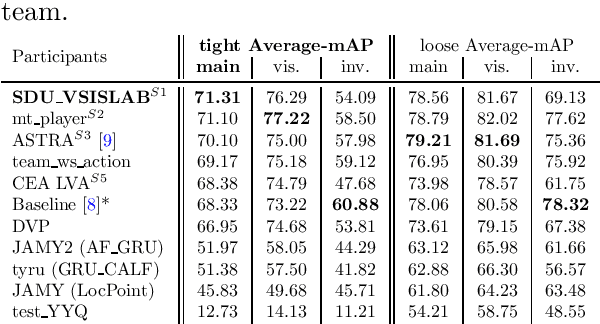


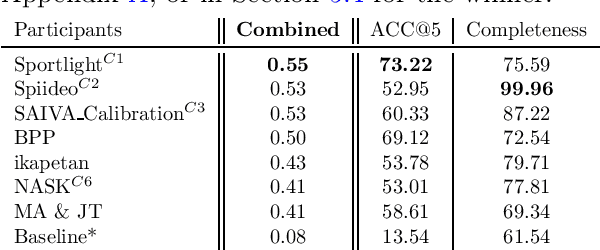
Abstract:The SoccerNet 2023 challenges were the third annual video understanding challenges organized by the SoccerNet team. For this third edition, the challenges were composed of seven vision-based tasks split into three main themes. The first theme, broadcast video understanding, is composed of three high-level tasks related to describing events occurring in the video broadcasts: (1) action spotting, focusing on retrieving all timestamps related to global actions in soccer, (2) ball action spotting, focusing on retrieving all timestamps related to the soccer ball change of state, and (3) dense video captioning, focusing on describing the broadcast with natural language and anchored timestamps. The second theme, field understanding, relates to the single task of (4) camera calibration, focusing on retrieving the intrinsic and extrinsic camera parameters from images. The third and last theme, player understanding, is composed of three low-level tasks related to extracting information about the players: (5) re-identification, focusing on retrieving the same players across multiple views, (6) multiple object tracking, focusing on tracking players and the ball through unedited video streams, and (7) jersey number recognition, focusing on recognizing the jersey number of players from tracklets. Compared to the previous editions of the SoccerNet challenges, tasks (2-3-7) are novel, including new annotations and data, task (4) was enhanced with more data and annotations, and task (6) now focuses on end-to-end approaches. More information on the tasks, challenges, and leaderboards are available on https://www.soccer-net.org. Baselines and development kits can be found on https://github.com/SoccerNet.
1st Workshop on Maritime Computer Vision 2023: Challenge Results
Nov 28, 2022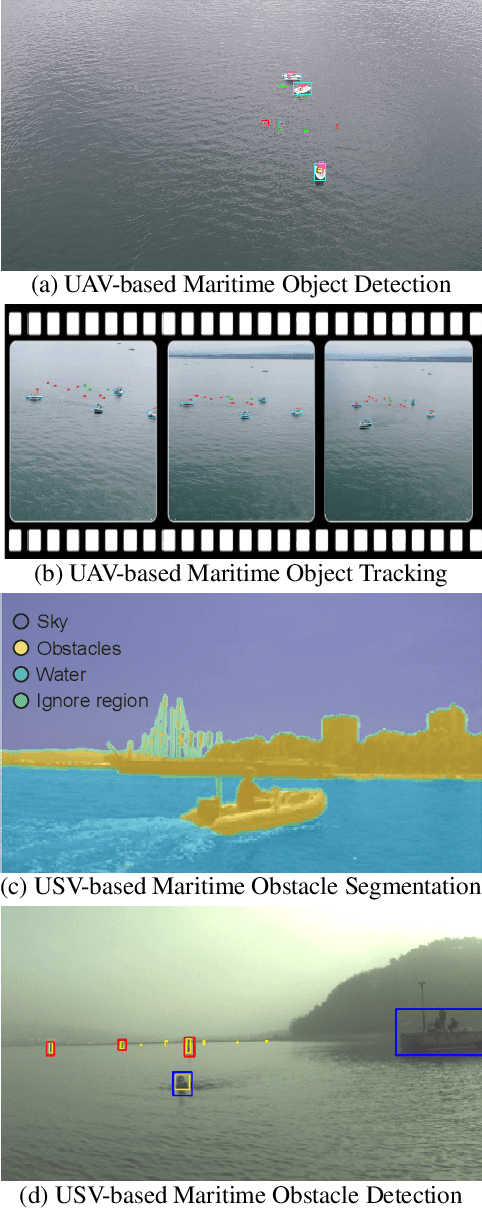
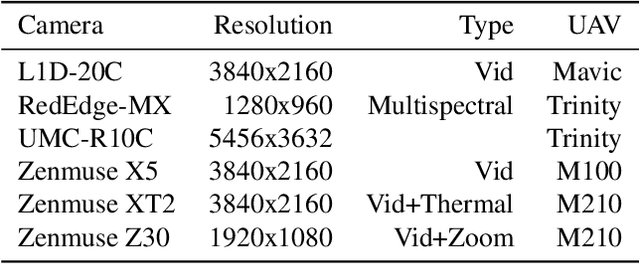
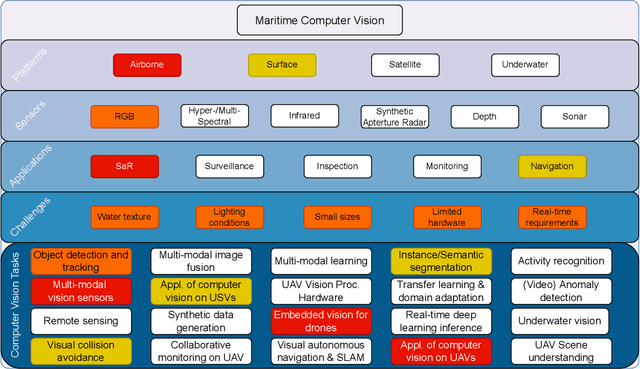
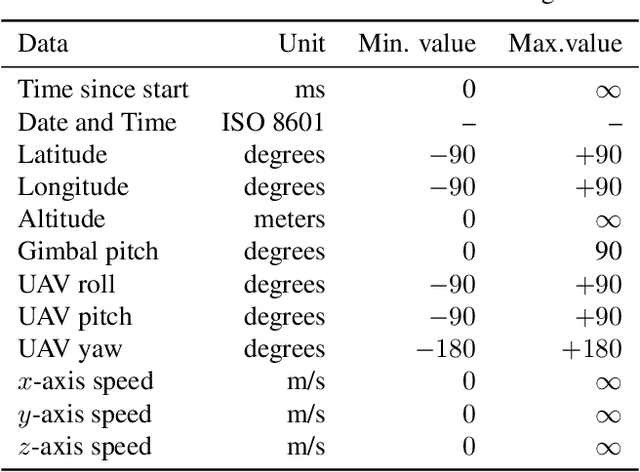
Abstract:The 1$^{\text{st}}$ Workshop on Maritime Computer Vision (MaCVi) 2023 focused on maritime computer vision for Unmanned Aerial Vehicles (UAV) and Unmanned Surface Vehicle (USV), and organized several subchallenges in this domain: (i) UAV-based Maritime Object Detection, (ii) UAV-based Maritime Object Tracking, (iii) USV-based Maritime Obstacle Segmentation and (iv) USV-based Maritime Obstacle Detection. The subchallenges were based on the SeaDronesSee and MODS benchmarks. This report summarizes the main findings of the individual subchallenges and introduces a new benchmark, called SeaDronesSee Object Detection v2, which extends the previous benchmark by including more classes and footage. We provide statistical and qualitative analyses, and assess trends in the best-performing methodologies of over 130 submissions. The methods are summarized in the appendix. The datasets, evaluation code and the leaderboard are publicly available at https://seadronessee.cs.uni-tuebingen.de/macvi.
Body Part-Based Representation Learning for Occluded Person Re-Identification
Nov 07, 2022



Abstract:Occluded person re-identification (ReID) is a person retrieval task which aims at matching occluded person images with holistic ones. For addressing occluded ReID, part-based methods have been shown beneficial as they offer fine-grained information and are well suited to represent partially visible human bodies. However, training a part-based model is a challenging task for two reasons. Firstly, individual body part appearance is not as discriminative as global appearance (two distinct IDs might have the same local appearance), this means standard ReID training objectives using identity labels are not adapted to local feature learning. Secondly, ReID datasets are not provided with human topographical annotations. In this work, we propose BPBreID, a body part-based ReID model for solving the above issues. We first design two modules for predicting body part attention maps and producing body part-based features of the ReID target. We then propose GiLt, a novel training scheme for learning part-based representations that is robust to occlusions and non-discriminative local appearance. Extensive experiments on popular holistic and occluded datasets show the effectiveness of our proposed method, which outperforms state-of-the-art methods by 0.7% mAP and 5.6% rank-1 accuracy on the challenging Occluded-Duke dataset. Our code is available at https://github.com/VlSomers/bpbreid.
SoccerNet 2022 Challenges Results
Oct 05, 2022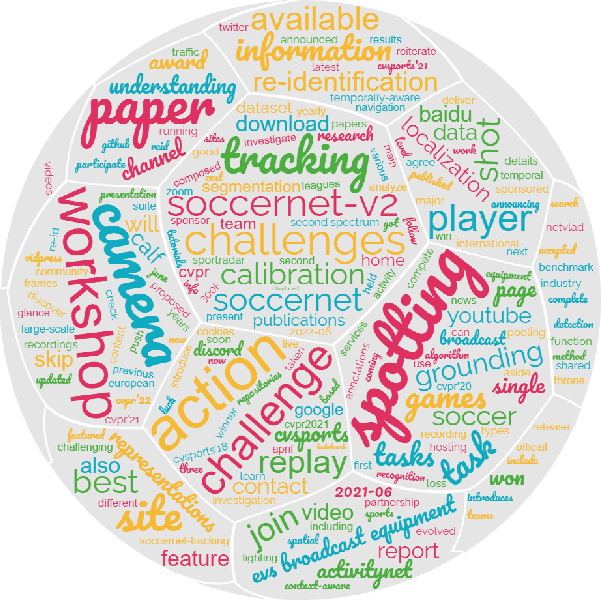



Abstract:The SoccerNet 2022 challenges were the second annual video understanding challenges organized by the SoccerNet team. In 2022, the challenges were composed of 6 vision-based tasks: (1) action spotting, focusing on retrieving action timestamps in long untrimmed videos, (2) replay grounding, focusing on retrieving the live moment of an action shown in a replay, (3) pitch localization, focusing on detecting line and goal part elements, (4) camera calibration, dedicated to retrieving the intrinsic and extrinsic camera parameters, (5) player re-identification, focusing on retrieving the same players across multiple views, and (6) multiple object tracking, focusing on tracking players and the ball through unedited video streams. Compared to last year's challenges, tasks (1-2) had their evaluation metrics redefined to consider tighter temporal accuracies, and tasks (3-6) were novel, including their underlying data and annotations. More information on the tasks, challenges and leaderboards are available on https://www.soccer-net.org. Baselines and development kits are available on https://github.com/SoccerNet.
 Add to Chrome
Add to Chrome Add to Firefox
Add to Firefox Add to Edge
Add to Edge